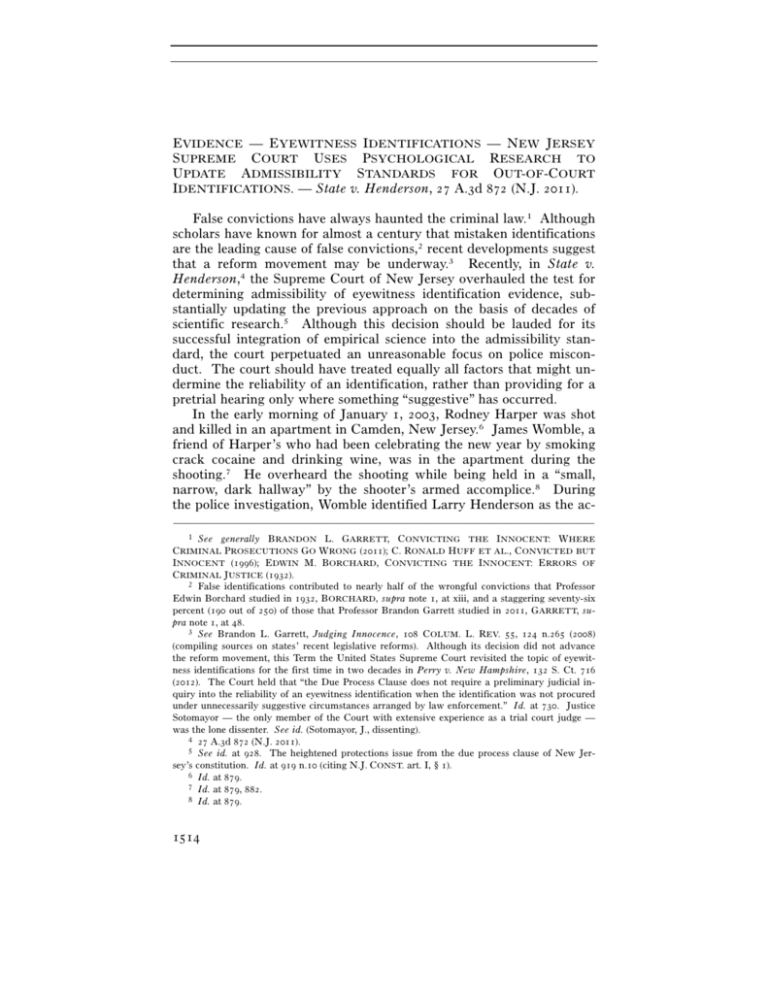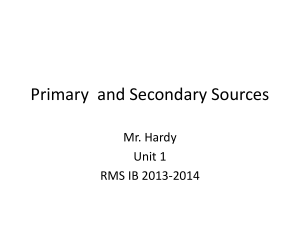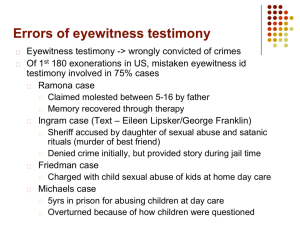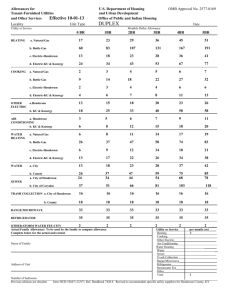State v. Henderson, 27 A.3d 872 (NJ 2011).
advertisement

EVIDENCE — EYEWITNESS IDENTIFICATIONS — NEW JERSEY SUPREME COURT USES PSYCHOLOGICAL RESEARCH TO UPDATE ADMISSIBILITY STANDARDS FOR OUT-OF-COURT IDENTIFICATIONS. — State v. Henderson, 27 A.3d 872 (N.J. 2011). False convictions have always haunted the criminal law.1 Although scholars have known for almost a century that mistaken identifications are the leading cause of false convictions,2 recent developments suggest that a reform movement may be underway.3 Recently, in State v. Henderson,4 the Supreme Court of New Jersey overhauled the test for determining admissibility of eyewitness identification evidence, substantially updating the previous approach on the basis of decades of scientific research.5 Although this decision should be lauded for its successful integration of empirical science into the admissibility standard, the court perpetuated an unreasonable focus on police misconduct. The court should have treated equally all factors that might undermine the reliability of an identification, rather than providing for a pretrial hearing only where something “suggestive” has occurred. In the early morning of January 1, 2003, Rodney Harper was shot and killed in an apartment in Camden, New Jersey.6 James Womble, a friend of Harper’s who had been celebrating the new year by smoking crack cocaine and drinking wine, was in the apartment during the shooting.7 He overheard the shooting while being held in a “small, narrow, dark hallway” by the shooter’s armed accomplice.8 During the police investigation, Womble identified Larry Henderson as the ac––––––––––––––––––––––––––––––––––––––––––––––––––––––––––––– 1 See generally BRANDON L. GARRETT, CONVICTING THE INNOCENT: WHERE CRIMINAL PROSECUTIONS GO WRONG (2011); C. RONALD HUFF ET AL., CONVICTED BUT INNOCENT (1996); EDWIN M. BORCHARD, CONVICTING THE INNOCENT: ERRORS OF CRIMINAL JUSTICE (1932). 2 False identifications contributed to nearly half of the wrongful convictions that Professor Edwin Borchard studied in 1932, BORCHARD, supra note 1, at xiii, and a staggering seventy-six percent (190 out of 250) of those that Professor Brandon Garrett studied in 2011, GARRETT, supra note 1, at 48. 3 See Brandon L. Garrett, Judging Innocence, 108 COLUM. L. REV. 55, 124 n.265 (2008) (compiling sources on states’ recent legislative reforms). Although its decision did not advance the reform movement, this Term the United States Supreme Court revisited the topic of eyewitness identifications for the first time in two decades in Perry v. New Hampshire, 132 S. Ct. 716 (2012). The Court held that “the Due Process Clause does not require a preliminary judicial inquiry into the reliability of an eyewitness identification when the identification was not procured under unnecessarily suggestive circumstances arranged by law enforcement.” Id. at 730. Justice Sotomayor — the only member of the Court with extensive experience as a trial court judge — was the lone dissenter. See id. (Sotomayor, J., dissenting). 4 27 A.3d 872 (N.J. 2011). 5 See id. at 928. The heightened protections issue from the due process clause of New Jersey’s constitution. Id. at 919 n.10 (citing N.J. CONST. art. I, § 1). 6 Id. at 879. 7 Id. at 879, 882. 8 Id. at 879. 1514 2012] RECENT CASES 1515 complice in a photo lineup, during which the primary investigators interrupted the procedure to encourage Womble to make an identification. 9 After a grand jury indicted Henderson for first-degree murder, the trial court granted his motion for a Wade hearing10 to determine the admissibility of the identification.11 The trial court heard testimony about the identification procedure and then applied the two-part Manson/Madison test.12 Under this test, “a court must first decide whether the procedure in question was in fact impermissibly suggestive. If the court does find the procedure impermissibly suggestive, it must then decide whether the objectionable procedure resulted in a ‘very substantial likelihood of irreparable misidentification.’”13 The trial court, despite noting that the investigators had deviated slightly from approved procedure,14 found “nothing in this case that was improper, and certainly nothing that was so suggestive as to result in a substantial likelihood of misidentification,” and therefore admitted the identification.15 Based on Womble’s in-court and out-of-court identifications and testimony about Henderson’s post-arrest statement alone, the jury convicted Henderson of reckless manslaughter, aggravated assault, and ––––––––––––––––––––––––––––––––––––––––––––––––––––––––––––– 9 After Womble hesitated to make an identification to the officer conducting the lineup, the investigators entered the interview room and told Womble “to focus, to calm down, to relax,” and to “just do what you have to do, and we’ll be out of here,” to which Womble responded that he “could make [an] identification.” The investigators then left and the identification process started anew. When shown Henderson’s picture, Womble “slammed his hand on the table and exclaimed, ‘[t]hat’s the mother [- - - - - -] there.’” Id. at 881 (alterations in original) (quoting trial court record). 10 See United States v. Wade, 388 U.S. 218, 241 (1967). 11 Henderson, 27 A.3d at 880. 12 Id. The United States Supreme Court established a standard for admissibility of identifications in Manson v. Brathwaite, 432 U.S. 98 (1977), which the New Jersey Supreme Court formally adopted in State v. Madison, 536 A.2d 254 (N.J. 1988). 13 Madison, 536 A.2d at 258 (quoting Simmons v. United States, 390 U.S. 377, 384 (1968)). In order to determine whether there is a substantial likelihood of irreparable misidentification, the court weighs “the corrupting effect of the suggestive identification itself,” id. at 262 (quoting Manson, 432 U.S. at 114), against five reliability factors: “the ‘opportunity of the witness to view the criminal at the time of the crime, the witness’s degree of attention, the accuracy of his prior description of the criminal, the level of certainty demonstrated at the time of the confrontation and the time between the crime and the confrontation.’” Id. (quoting Manson, 432 U.S. at 114 (citing Neil v. Biggers, 409 U.S. 188, 199–200 (1972))). 14 Henderson, 27 A.3d at 880–82. The procedure was for the most part consistent with guidelines issued by the New Jersey Attorney General. See OFFICE OF THE ATT’Y GEN., DEP’T OF LAW & PUB. SAFETY, ATTORNEY GENERAL GUIDELINES FOR PREPARING AND CONDUCTING PHOTO AND LIVE LINEUP IDENTIFICATION PROCEDURES (2001) [hereinafter ATTORNEY GENERAL GUIDELINES], available at http://www.nj.gov/oag/dcj/agguide/photoid.pdf. 15 Henderson, 27 A.3d at 882 (quoting trial court record) (internal quotation mark omitted). The trial court paid special attention to Womble’s confidence in his identification, his opportunity to view the defendant during the crime, and his apparently heightened sense of attention due to the presence of a weapon. See id. 1516 HARVARD LAW REVIEW [Vol. 125:1514 related weapons charges.16 On appeal, the Appellate Division of the Superior Court of New Jersey determined that the identification procedure was “impermissibly suggestive” and remanded the case for a new Wade hearing to determine whether the identification was nonetheless reliable.17 The Supreme Court of New Jersey granted certification in order to address the “current framework for evaluating the admissibility of [eyewitness identification] evidence,” and it remanded to the trial court “for a plenary hearing” to determine whether the Manson/Madison test remained viable “in light of recent scientific and other evidence.”18 During those proceedings, the Special Master thoroughly reviewed the scientific literature with the help of the parties and amici. The litigation produced over 360 exhibits, including more than 200 published scientific studies, and the testimony of seven experts, including some of the most renowned in the field of eyewitness identification.19 Much of the high court’s opinion was a thorough review of the lower court’s findings.20 The court, in discussing the various factors that affect a witness’s memory, divided the variables into two categories: system variables, such as lineup procedures, “which are within the control of the criminal justice system”; and estimator variables, such as the witness’s age, the lighting at the scene, and the time between the event and the identification, “over which the legal system has no control.”21 Based on these findings, the high court revised the Manson/Madison test to better reflect the current state of science and to generally heighten courts’ scrutiny of eyewitness identifications.22 First, the court lowered the standard for a Wade hearing, holding that a defendant carries an “initial burden of showing some evidence of ––––––––––––––––––––––––––––––––––––––––––––––––––––––––––––– 16 Id. at 882–83. The trial court instructed the jury on the reliability of the eyewitness identification. Id. This instruction was largely modeled on the factors discussed in Biggers, 409 U.S. at 199–200. 17 State v. Henderson, 937 A.2d 988, 998 (N.J. Super. Ct. App. Div. 2008). In making this determination, the court found that the investigating officers’ intrusion into the photo lineup “certainly violate[d] the spirit of the [Attorney General] Guidelines,” id. at 996, and held that a material breach of the Guidelines “warrants a presumption of impermissible suggestiveness,” id. at 998. 18 State v. Henderson, No. A-8-08, 2009 WL 510409, at *1–2 (N.J. Feb. 26, 2009). The court appointed the retired Honorable Geoffrey Gaulkin to preside as Special Master. Henderson, 27 A.3d at 884. 19 Henderson, 27 A.3d at 884. 20 See id. at 894–912. The court emphasized that in order for a scientific theory to be accepted as reliable, it would have to be “based on a sound, adequately-founded scientific methodology involving data and information of the type reasonably relied on by experts in the scientific field,” id. at 896 (quoting State v. Moore, 902 A.2d 1212, 1226 (N.J. 2006)) (internal quotation marks omitted), and generally accepted “within the relevant scientific community,” id. 21 Id. at 895. 22 Id. at 878. The court decided the case under the state constitution’s guarantee of due process. Id. at 919 n.10 (citing N.J. CONST. art. I, § 1). 2012] RECENT CASES 1517 suggestiveness” in order to trigger a hearing.23 Importantly, this initial showing of suggestiveness must be tied to a system variable and not to an estimator variable.24 If the defendant makes this initial showing, the state “must then offer proof to show that the proffered eyewitness identification is reliable,” considering all relevant system and estimator variables that psychologists have shown to have significant effects on the reliability of an identification.25 The defendant must also be given a chance to cross-examine eyewitnesses and present witnesses and evidence relevant to both system and estimator variables.26 Finally, if a court finds, after analyzing the “totality of the circumstances,” that there is a “very substantial likelihood of irreparable misidentification,” the identification should be suppressed.27 Otherwise, the trial judge should present “appropriate, tailored jury instructions.”28 The Henderson court emphasized that a trial court could end the hearing at any moment if it determined that the government had disproved the defendant’s initial showing.29 The court remanded to the trial court for a new Wade hearing to determine whether the eyewitness identification was admissible under the new standard.30 The Special Master, defendant, and amici all suggested lowering the threshold for a Wade hearing even further.31 In particular, the defendant requested that there be a reliability hearing in every case in which eyewitness testimony was an issue, while the Innocence Project would have had the defendant merely “allege that an identification was unreliable” before the burden would shift to the government to affirmatively prove that the identification was reliable.32 The court rejected these suggestions, citing concerns about the practical effectiveness, judicial efficiency, and philosophical bases of their approaches.33 ––––––––––––––––––––––––––––––––––––––––––––––––––––––––––––– 23 Id. at 920. Before Henderson, defendants in New Jersey had to “proffer . . . some evidence of impermissible suggestiveness” to trigger a Wade hearing. State v. Rodriquez, 624 A.2d 605, 609 (N.J. Super. Ct. App. Div. 1993) (emphasis added), aff’d, 637 A.2d 914 (N.J. 1994). 24 Henderson, 27 A.3d at 920. The court listed nine relevant system variables, including the presence of blind administration and pre-identification instructions, and how the lineup was constructed. Id. at 920–21. 25 Id. at 920. Relevant estimator variables include stress, distance, lighting, memory decay, and race bias. Id. at 921–22. 26 Id. at 920. 27 Id. 28 Id. In particular, the court held that an instruction on the unreliability of cross-racial identification should be given “whenever cross-racial identification is in issue,” id. at 926, extending the rule established in State v. Cromedy, 727 A.2d 457, 467 (N.J. 1999), which required crossracial identification instruction only when such an identification is a “critical issue” and is uncorroborated by other evidence. 29 Henderson, 27 A.3d at 920. 30 Id. at 926. 31 Id. at 922–23. 32 Id. at 915–16. 33 Id. at 922–24. 1518 HARVARD LAW REVIEW [Vol. 125:1514 Henderson’s social science–based approach to the admissibility of eyewitness evidence is a laudable accomplishment. Although New Jersey had made significant strides in reforming its eyewitness identification procedures in the years before Henderson,34 the Manson/Madison test that continued to control admissibility during that period was an obsolete relic of the U.S. Supreme Court’s 1974 Neil v. Biggers decision.35 Additionally, the Henderson court wisely proceeded with caution, noting that its new framework had to be “flexible enough to serve twin aims: to guarantee fair trials to defendants . . . and to protect the State’s interest in presenting critical evidence at trial.”36 The court’s solution will likely compel New Jersey’s police departments to adopt better identification procedures and will increase judicial scrutiny of identification evidence. However, the court should have also provided for an admissibility hearing in cases where, despite a lack of evidence of suggestiveness, other circumstances indicate that an identification would be particularly unreliable. The procedural structure of the Henderson test continues to place undue focus on police suggestiveness37 rather than on reliability generally.38 By tying the initial burden to system variables — thereby making external suggestion necessary for suppression — Henderson will deter police misconduct. However, identification testimony that is untainted by procedural suggestiveness, but otherwise exhibits indicia of unreliability related to estimator variables, still poses a risk of false conviction since the defendant cannot make the initial showing that would entitle him to a ––––––––––––––––––––––––––––––––––––––––––––––––––––––––––––– 34 See, e.g., State v. Delgado, 902 A.2d 888, 896–97 (N.J. 2006) (mandating that law enforcement officers keep written records of out-of-court identification procedures); State v. Cromedy, 727 A.2d 457, 467 (N.J. 1999); ATTORNEY GENERAL GUIDELINES, supra note 14. 35 409 U.S. 188 (1972). The Biggers Court failed to recognize all scientifically relevant factors, and, moreover, empirical research has since demonstrated that a witness’s confidence in the accuracy of his identification and even the accuracy of his prior descriptions are not useful predictors of reliability. See, e.g., BRIAN L. CUTLER & STEVEN D. PENROD, MISTAKEN IDENTIFICATION 95 (1995). 36 Henderson, 27 A.3d at 919. 37 Granted, police suggestiveness continues to be a significant concern because of police departments’ notoriously slow rate for adoption of new practices. See Erica Goode & John Schwartz, Police Lineups Start to Face Fact: Eyes Can Lie, N.Y. TIMES, Aug. 29, 2011, at A1 (noting that a study revealed that in Middlesex County, Massachusetts, “where police officers are urged but not required to conduct blinded lineups, they recorded doing so in only 2 of 11 photo arrays”). 38 But see State v. Chen, 27 A.3d 930, 932 (N.J. 2011) (holding that the first Henderson hurdle may be cleared by showing evidence of suggestiveness caused by private actors). Chen, a companion to Henderson, extends the entitlement to Wade hearings to cases in which there is evidence of nonpolice suggestiveness. The court in Chen seemed to appreciate the importance of basing the barrier to a Wade hearing on indicia of reliability rather than on impermissible police conduct: “Recent social science research reveals that suggestive conduct by private actors . . . can undermine the reliability of eyewitness identifications . . . . We consider that evidence in light of the court’s traditional gatekeeping role to ensure that unreliable, misleading evidence is not presented to jurors.” Id. at 932. 2012] RECENT CASES 1519 Wade hearing.39 Because “reliability is the linchpin in determining the admissibility of identification testimony,”40 such evidence should be suppressed. “Suggestiveness” is a somewhat arbitrary concept on which to base the defendant’s burden, since lineups are inherently suggestive.41 That is, the very act of inviting a witness to view a lineup and make an identification suggests to the witness that some member of the lineup is the criminal.42 By this logic, since the lineup procedure itself is “some evidence of suggestiveness,”43 any defendant positively identified in a lineup should be entitled to a Wade hearing. As imposed by the court, the “suggestiveness” barrier assumes some baseline — and arbitrary — level of procedure, variation from which triggers a hearing. The “suggestiveness” requirement seems especially arbitrary in light of the court’s decision in State v. Chen, 44 Henderson’s companion case, in which the court allowed nonpolice suggestiveness to trigger a pretrial hearing. 45 The court supplied no satisfactory theoretical reason that suggestive behavior by a private party justifies a pretrial hearing while estimator variables do not — after all, both these factors affect reliability and are outside of state control. Indeed, the U.S. Supreme Court in Perry v. New Hampshire46 recently suggested that there is no difference between suggestiveness generally and other sources of unreliability. 47 Given that Chen implies that sources of unreliability outside of the state’s control may warrant suppression of identification evidence, the most plausible justification for the “suggestiveness” barrier is to limit arbitrarily the number of pretrial hearings.48 Ironically, since “suggestiveness” is itself an arbitrary concept, the decision may nonetheless invite frivolous Wade motions. ––––––––––––––––––––––––––––––––––––––––––––––––––––––––––––– 39 In Professor Garrett’s study, there was no evidence “that police contaminated the eyewitness identifications” in twenty-two percent of the cases of misidentification in which there was a significant trial record (36 out of 161). GARRETT, supra note 1, at 49. 40 Manson v. Brathwaite, 432 U.S. 98, 114 (1977). 41 Indeed, Chief Justice Roberts alluded to this fact in oral argument in Perry. See Transcript of Oral Argument at 15–16, Perry v. New Hampshire, 132 S. Ct. 716 (2012) (No. 10-8974). 42 Empirical research confirms this account. In consolidating the results from four studies that simulated “nonstressful conditions” and brief viewings with only short delays between incident and identification, Doctors Brian Cutler and Steven Penrod showed that the average percentage of correct identifications was 41.8%, while the average percentage of false identifications was a startling 35.8%. CUTLER & PENROD, supra note 35, at 12. 43 Henderson, 27 A.3d at 920–21. 44 27 A.3d 930 (N.J. 2011). 45 See id. at 932. 46 132 S. Ct. 716 (2012). 47 Id. at 727 (implying that the Court could not “rationally distinguish suggestiveness from other factors bearing on the reliability of eyewitness evidence”). 48 Cf. Henderson, 27 A.3d at 923 (“[W]e are mindful of the practical impact of today’s ruling. . . . [T]o allow hearings in the majority of identification cases might overwhelm the system . . . .”). 1520 HARVARD LAW REVIEW [Vol. 125:1514 A key challenge for any evidentiary reform is the threat of disturbing the jury’s central role as primary decisionmaker.49 Although faith in juries is an important virtue of our criminal procedure, courts should not be hesitant to make initial determinations that evidence is insufficiently reliable, particularly when a certain kind of evidence has an inherent persuasiveness that a jury may be unable to weigh properly. 50 Since many studies have shown that juries are particularly susceptible to placing too much faith in eyewitness identifications,51 the courts are justified in scrutinizing identifications more closely than other testimony. In this respect, the New Jersey Supreme Court relied on an outdated epistemology; it too readily dismissed the defendant and amici’s suggestion that eyewitness memory should be treated like trace evidence,52 instead implying that eyewitness identifications should be handled as any other form of testimonial evidence.53 However, there is good reason to believe that the standard due process protections — in particular, cross-examination — are insufficient to allow the jury to competently address the reliability of eyewitness identifications. Eyewitness identifications are unlike regular testimony, as a psychological matter.54 Because psychology has successfully established how various factors impact the reliability of eyewitness identifications, the court is more justified in performing a gatekeeping role.55 ––––––––––––––––––––––––––––––––––––––––––––––––––––––––––––– 49 Even Professor Elizabeth Loftus, a vocal and active critic of unskeptical acceptance of eyewitness testimony, admits that “[a] jury should probably hear all information necessary to reach a proper decision and judge its adequacy for themselves.” ELIZABETH F. LOFTUS, EYEWITNESS TESTIMONY 188 (1979). 50 The most prevalent example of a trial court’s acting as a gatekeeper for ensuring the reliability of evidence is in determining whether to admit expert scientific testimony. See, e.g., Daubert v. Merrell Dow Pharm., Inc., 509 U.S. 579, 597 (1993). 51 See, e.g., LOFTUS, supra note 49, at 9–10 (describing a study in which the conviction rate by mock jurors rose by fifty percentage points when an eyewitness identification was provided, despite the fact that the eyewitness had vision so poor he could not possibly have seen the suspect’s face); see also Peter J. Smith, New Legal Fictions, 95 GEO. L.J. 1435, 1452–55 (2007) (citing numerous sources to support the proposition that “[t]he presumption that jurors can competently assess the reliability of eyewitness testimony . . . is a new legal fiction,” id. at 1454–55). 52 See Henderson, 27 A.3d at 924. 53 Id. (“[W]e continue to rely on people as the conduits of their own memories, on attorneys to cross-examine them, and on juries to assess the evidence presented.”); see also Perry v. New Hampshire, 132 S. Ct. 716, 728 (2012) (“[T]he jury, not the judge, traditionally determines the reliability of evidence.”). 54 See John W. Shepherd & Hadyn D. Ellis, Face Recall — Methods and Problems, in PSYCHOLOGICAL ISSUES IN EYEWITNESS IDENTIFICATION 87, 88 (Siegfried Ludwig Sporer et al. eds., 1996) (noting that, unlike recall memory such as regular ask-and-answer testimony, facial recognition is processed holistically). 55 Cf. State v. Moore, 902 A.2d 1212, 1227 (N.J. 2006) (holding hypnotically refreshed testimony inadmissible, based largely on common scientific understanding that the method is unreliable). Importantly, the problems with hypnotically refreshed testimony are remarkably similar to the problems with eyewitness testimony: “suggestiveness that may be unintended, or even unperceived, by the hypnotist[,] . . . the inability of expert witnesses and lay observers to distinguish 2012] RECENT CASES 1521 Furthermore, there are sound doctrinal reasons to adopt a standard tied entirely to reliability. Although the U.S. Supreme Court in Perry backpedaled from treating the admissibility of unreliable evidence as a due process concern,56 the New Jersey Supreme Court has already recognized reliability as a due process concern.57 Right now, the court relies on the ability of jurors, with the aid of enhanced jury instructions and expert testimony, to properly pick out and resolve essential identification issues even in cases in which an identification is the crucial centerpiece of the prosecution’s case.58 However, despite these ameliorative measures, juries remain largely unable to properly assess the reliability of many identifications. The only effective safeguard, when courts and experts agree on the testimony’s unreliability, is exclusion. While Henderson was a major step in the right direction, the court should have made a firm judgment that a conviction cannot be sustained on unreliable eyewitness identifications, regardless of the cause of the unreliability. Given the increasing social awareness of the risk of error inherent in eyewitness identifications and the resulting false convictions, continued laxity by courts threatens to undermine public confidence in the accuracy of the judicial process and, with it, the popular legitimacy of our criminal justice system.59 It is therefore appropriate for courts to scrutinize more closely identifications that informed observers would agree are unreliable and to prevent juries from being swayed by a misleading veneer of persuasiveness. ––––––––––––––––––––––––––––––––––––––––––––––––––––––––––––– between true memories and pseudomemories[,] and . . . increased confidence in recall that is unwarranted and renders cross-examination largely ineffective.” Id. at 1221. 56 See Perry, 132 S. Ct. at 728 (“Our unwillingness to enlarge the domain of due process . . . rests, in large part, on our recognition that the jury, not the judge, traditionally determines the reliability of evidence.”). 57 See, e.g., State v. Michaels, 642 A.2d 1372, 1380 (N.J. 1994) (“This Court has a responsibility to ensure that evidence admitted at trial is sufficiently reliable so that it may be of use to the finder of fact who will draw the ultimate conclusions of guilt or innocence. That concern implicates principles of constitutional due process.”). 58 The relative benefits of jury instructions and expert testimony is an issue of hot debate. Compare CUTLER & PENROD, supra note 35, at 264 (concluding that expert testimony is more effective than judges’ instructions as a safeguard), with Christian Sheehan, Note, Making the Jurors the “Experts”: The Case for Eyewitness Identification Jury Instructions, 52 B.C. L. REV. 651, 677 (2011) (arguing that “[j]ury instructions help to avoid any prejudice that may result from jurors giving inordinate weight to the testimony of an expert”). 59 Cf. Charles Nesson, The Evidence or the Event? On Judicial Proof and the Acceptability of Verdicts, 98 HARV. L. REV. 1357, 1392 (1985) (“[E]xtremes in the pursuit of truth can impair the system’s capacity to generate acceptable verdicts and thus undercut its ability to project the norms embodied in the substantive law.”).





